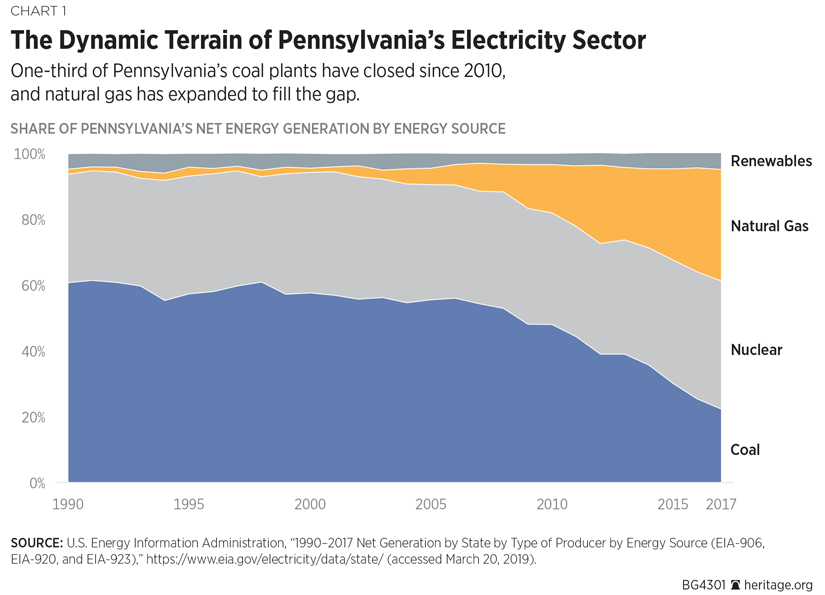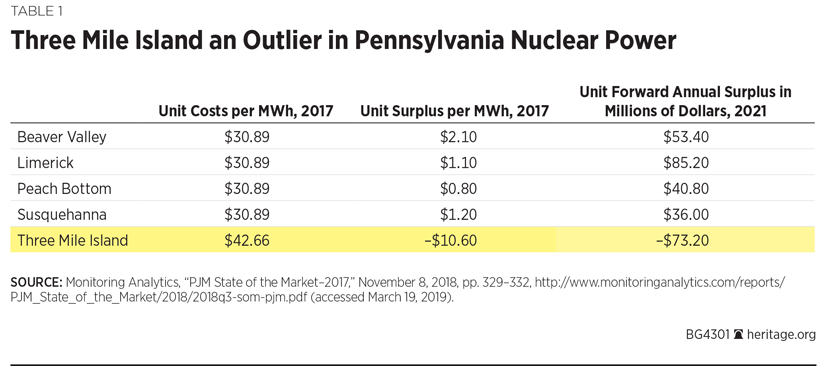Pennsylvania is considering becoming the fifth state to implement government subsidies for nuclear power plants. State legislators introduced a bill on March 11, 2019—the Keep Powering Pennsylvania Act—that would expand the state’s renewable energy standards to mandate the purchase of electricity from Pennsylvania’s five nuclear power plants, as well as create a stream of financial subsidies to those same plants regardless of their economic viability. Proponents of the Keep Powering Pennsylvania Act and similar policies argue that keeping nuclear power plants from closing is necessary to reduce carbon-dioxide emissions and preserve jobs, and that government subsidies are less costly than the lost economic activity from allowing uncompetitive plants to close.REF
Such thinking is short-sighted. Yes, nuclear power emits no air pollutants or carbon-dioxide emissions and is a reliable, energy-dense source of power that produces hundreds of megawatts for decades with very little physical footprint. However, state governments must see beyond the immediate economic plight of specific nuclear power plants and consider the ramifications that taxpayer subsidies have on the broader framework of electricity choice and competition, which has greatly benefitted Pennsylvania’s residents and businesses.
The State of Pennsylvania’s Electricity Sector
Pennsylvania’s electricity sector has changed considerably over the past several decades, especially given the commonwealth’s decision to move from state-sanctioned monopolies to competitive electricity markets in 1996. Like in the rest of the country, electricity consumption in Pennsylvania has remained flat or decreased after years of growth and is expected to continue decreasing over the next five years.REF Carbon-dioxide emissions have fallen 23 percent since 1980.REF Since 2010, one-third of Pennsylvania’s coal plants have closed, and natural gas has gone from an irrelevant source of electricity to meeting over 34 percent of Pennsylvania’s electricity needs.REF
Even with announced closures, Pennsylvanians will have sufficient access to reliable electricity in the future. In its Electric Power Outlook for Pennsylvania 2017–2022, the Public Utility Commission concluded “that sufficient generation, transmission and distribution capacity exists to reasonably meet the needs of Pennsylvania’s electricity consumers for the foreseeable future.”REF The same study reports that over 2,000 megawatts (MW) of generating capacity were retired in 2017, but that over 9,600 MW were being built—more than in any of the past four years.REF PJM, the regional electricity transmission and reliability organization in which Pennsylvania participates, has 14,000 MW of excess reserves, and the North American Electric Reliability Corporation states that the PJM region has sufficient reserves through 2027, even with announced closures.REF
Pennsylvania’s Nuclear Bailout Proposal
The Keep Powering Pennsylvania Act, H.B. 11, expands Pennsylvania’s Alternative Energy Portfolio Standard Program to include nuclear energy.REF Adopted in 2004, the existing program requires that 18 percent of electricity come from renewable energy technologies by 2021. Of that, 8 percent must come from Tier I resources,REF and 10 percent from Tier II.REF Legislation would create a Tier III principally focused on a nuclear energy credit program. Distribution companies must purchase credits for half the electricity sold in their region by Tier III qualifying companies, or be penalized with compliance payments, which will be split between the existing sustainable energy fund and Tier III qualifying companies. The program would end with implementation of a carbon-dioxide tax of at least $15 per ton.
The legislation intends to prevent the closure of the five nuclear power plants operating in Pennsylvania. Of these, Exelon has announced plans to close Three Mile Island in October 2019, and FirstEnergy has announced plans to close Beaver Valley in 2021 as part of a 2016 decision to divest its power-generating assets.REF
The Varied Costs of a Subsidy Program
There are obvious and immediate costs of mandating purchases of electricity from certain power plants. The Kleinman Center for Energy Policy at the University of Pennsylvania estimates that costs for an earlier but similar version of H.B. 11 would be around $500 million in the first year.REF
However, there are costs beyond the immediate impact that Pennsylvania customers will see in their utility bills. A nuclear energy mandate and credit program is principally the adoption of a government-centric approach and rejection of the competitive electricity market that has served Pennsylvania families and businesses well. Subsidy and mandate programs:
1. Are patently unfair to past investors and chill future investment. Companies have made investments in the past decade anticipating Pennsylvania customer needs with the confidence that they and their competitors would both abide by market rules.REF Legislators engage in “bait and switch” by proposing new rules that socialize certain costs across customers and exempt 44 percent of Pennsylvania’s market (representing renewables and nuclear) from having to compete for customers. Political interventions also destroy future investment confidence in the face of ever-changing and arbitrary political winds. While mandating the purchase of nuclear energy will save those jobs for a time, it will also prevent the creation of others.
2. Create a barrier to entry that discourages organic innovation. Technology and energy-source-neutral competition in electricity markets allows the endless creativity of people to meet customer energy needs and preferences while protecting customers from unwise investments. In contrast, a government-centric electricity sector is a “fundamentally permission-based system” where investments require highly political negotiations and approval from commissioners, or legislatures subsidize investment in the hopes of forcing adoption of politically preferred technologies.REF New entry is challenging enough, especially for smaller, innovative companies with new technologies and products. Companies would face an additional barrier to entry if government insulates uneconomic competitors.
3. Stifle healthy competitive pressure. Competitive markets force power suppliers and investors to consider the costs and benefits to their customers and incentivize discipline to be more efficient—in operations, investments, and regulatory compliance—than competitors. Government-centric approaches use policy to guarantee that some, if not all, costs of service are covered, thus reducing incentives to cut costs beyond what is politically necessary.REF
Market pressure has been good even for the nuclear industry. For example, in direct response to tough economic competition, the Nuclear Energy Institute organized nuclear power plants nationally to find operating efficiencies that ultimately reduced costs by 19 percent, resulting in $1.6 billion in savings.REF Nuclear power plants in competitive markets aggressively reduced the amount of time spent offline for refueling and adopted efficiencies to increase production,REF while Pennsylvania’s nuclear power plants have operating costs well below the industry average of $33.50 per MW-hour.REF Subsidizing plants only calcifies existing industry and technology.
Undoubtedly, some companies have not been able to endure market pressure, creating room for others to fill the void. For example, it is precisely because Pennsylvania has a competitive market that it has been able to enjoy the benefits of the shale gas revolution. A mandate and subsidy program muddles these market signals.
4. Ignore customer preferences and put lobbyists first. H.B. 11 would override customer choice by forcing customers to fund the mandated use of nuclear power plants. Far from being consumer-focused, the proposal rewards political connections and cronyism. In contrast, competition in electricity services allows greater customer choice through the power of the consumers’ own dollars. Choice comes not only in the form of resources (renewables, conventional fuels, or a mix) but also in financial products (such as fixed rates, risk preferences, indexed rates, or short- or long-term contracts). In the end, because electricity providers have to work for their customers, prices are competitive and quality improves. PJM’s competitive markets have saved customers roughly $3 billion a year since 1997.REF
5. Will not prevent eventual closure. Not all of Pennsylvania’s reactors are in economic hardship. It makes no sense to subsidize profitable companies, as H.B. 11 would do. However, even subsidizing failing ones will not solve the challenges facing surrounding communities when nuclear power plants eventually close, either by the healthy creative destruction of competitive markets or by plants reaching the end of operating licenses. Each nuclear power plant in Pennsylvania is a part in a larger, dynamic economy. The way to a thriving economy is by creating a competitive tax and regulatory environment where companies want to do business. Fossilizing communities by subsidizing current employers will not lead to a healthy economy or a strong tax base in the long term.
Even so, closing and decommissioning a nuclear power plant is a long, multimillion-dollar process that does not completely turn off the tap of employment and local tax revenues. Though staff has been downsized, hundreds of employees in Wisconsin, California, Florida, and New Jersey are still working on closed reactor sites to prepare them for final decommissioning as far as 60 years out.REF Rather than subsidizing nuclear power plants, Dauphin County (Three Mile Island) and Beaver County (Beaver Valley) would benefit from studying the experiences of these communities.
Hold Firm to Electricity Choice
Legislators should defend competitive markets and eliminate policies that created market unfairness in the first place. Rather than expand the Alternative Energy Portfolio Standard Program, Pennsylvania should eliminate all energy subsidies and trust customers to choose their electricity services. In 2015, Congress moved closer to a competitive national energy sector when it put wind and solar federal tax credits on a schedule to sunset in 2022. Pennsylvania should do likewise.
A system designed with the central premise that market competition yields better results for customers in the immediate and long term is fundamentally incompatible with top-down measures to protect certain players from competition. Pennsylvania’s H.B. 11 proposal would block market efficiencies from occurring and reward inefficient power producers. A bailout is not pro-consumer, pro-jobs, or pro-nuclear. Maintaining a system of genuine market competition is more beneficial to Pennsylvania families and businesses than saving a few politically preferred power plants.
—Katie Tubb is Policy Analyst in the Thomas A. Roe Institute for Economic Policy Studies, of the Institute for Economic Freedom, at The Heritage Foundation.




